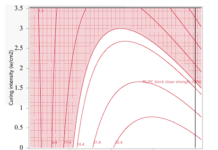Monitoring Urethane Adhesives and Coatings for Primary Aromatic Amines
Whether the adhesive or coating is UV/EB or conventional, if it contains a polyurethane resin, it is recommended to monitor the cured materials and articles for residual reaction byproduct primary aromatic amines (PAA). The importance for the manufacturer to test the finished project is not only related to establishing the cure time but also to test for those PAA that are classified as carcinogenic. Additionally, this testing allows the PAA levels to be monitored for the post-cure decay time for which they will be below a level of exposure concern to the consumer. In the food and consumer-sensitive packaging industry, PAA also are known to be a residual impurity in certain nitrogen-containing pigments and dyes.
Post-cure is a familiar concept in the coatings industry for those products which contain drying oils which cure (dry) by oxidation. The post-cure of adhesives is particularly challenging as the conditions of use result in the adhesive being buried between two surfaces or materials. This is where the monitoring is designed for the type of use and testing is performed, with the results charted as time vs. PAA amounts. In essence, this is a measurement of the decay rate of the specific PAA known to be present. The usual specification for the adhesive’s full-cure time is two to four days. Industrial coatings also have specific cure time. The limit of detection (LOD) is recommended to be less than 1 part per billion (µg/kg or ppb).
The regulation of known or suspected carcinogenic PAA is the subject of FDA and EU Commission food contact regulations and, additionally, US OEHHA California Proposition 65. The FDA indirect food additive regulation prohibits the use of a known PAA in food contact substances. The EU Plastics Regulation prohibits the sum total of all PPA in a food contact article to be less than 10 µg/kg (10 ppb) of food or food simulant.
Contact RadTech for further specific information.
 Gregory V. Pace, Ph.D., M.S.,
Gregory V. Pace, Ph.D., M.S.,
consultant, regulatory & product stewardship
FROM THE WEST COAST
California Energy Commission Awards $5 Million to UV Project
The California Energy Commission (CEC) has awarded $5,000,000 to the Lawrence Berkeley National Laboratory to design and build advanced modular homes in Bay Point in Contra Costa County, which is considered a disadvantaged community in California. The demonstration project will consist of three townhome units on a single site and include solar and energy storage, advanced high-efficiency electric heat pump equipment, and a lower cost of ownership over 10 years than typical modular homes. The project is part of the California Energy Commission’s Electric Program Investment Charge (EPIC) program, which invests in scientific and technological research to meet the state’s energy and climate goals.
According to the CEC, the prefabricated housing industry generally has minimal research and product innovation, except in meeting code requirements. The agency sought to involve key prefabricated and manufactured home industry stakeholders in the development process so as to increase the opportunity to gain widespread and immediate market acceptance. Radlaunch Award recipient Mighty Buildings has been engaged to construct the homes’ walls using its 3D printing technology at its Oakland, California, facility.
RadTech’s RadLaunch program supports companies working to commercialize processes in the UV/EB/LED industry. “Many companies that have an excellent idea and perhaps early positive lab results are missing the contacts and network that will take them past the concept phase. One of the most valuable things that RadLaunch offers is an introduction to member companies, such as material and equipment suppliers and end users, that can furnish support and guidance,” said veteran RadTech member Mike Idacavage, co-chair, RadLaunch.
Mighty Buildings created a proprietary printing material to cure an extrudable gel with UV technology. It is an unreinforced thermoset resin which the company refers to as a composite – essentially, a mixture of resin with a UV initiator and other proprietary materials. The material cures quickly enough to be able to support its own weight, enabling printing of unsupported spans and organic shapes. The prefabricated units are low-carbon and energy efficient. The Mighty House is a prefabricated, 3D-printed housing unit that startup Mighty Buildings says can be built in less than a week. 3D printing technology allows production of the modular houses and building components much faster than compared to traditional construction. Each 3D-printed home is estimated to prevent 1,100 to 2,000 kilograms of CO2.
At the beginning of 2017, California changed its state regulations to encourage the construction of accessory dwelling units (ADU) – standalone housing units built on the same property of a house or other primary dwelling, which can be used for guest or office spaces, or as small, affordable living spaces. Initially, there were challenges with local municipalities in the processing of permits for the projects. Regulatory hurdles were reportedly bottlenecks for the projects. Construction of the first homes began in Desert Hot Springs, California, in early 2022, which are claimed to be the world’s first 3D-printed, net-zero homes.
Automotive Coatings Rule Amendment Planned
The South Coast Air Quality Management District announced its plans to amend the rule for automotive coatings (Rule 1151 – Motor Vehicle and Mobile Equipment Non-Assembly Line Coating Operations). A public consultation meeting was held in November of 2023 to solicit input from stakeholders. The agency currently is conducting a survey for manufacturers that sell automotive refinishing coatings and products for use within the South Coast AQMD that are subject to the regulation. According to the district, “The intent of the survey is to assist the South Coast AQMD staff to understand the extent to which exempt solvents are used to formulate compliant products.”
The main exempt compounds of interest for this survey are para-chlorobenzotrifluoride (pCBtF), also known as Oxsol, and tertiary-Butyl Acetate (t-BAc). The survey results will be used to establish Volatile Organic Compound (VOC) limits and propose prohibition timelines for t-BAc and pCBtF. This survey was sent to coatings manufacturers on December 22, 2023. Next meetings and a rule adoption schedule are yet to be determined.
 Rita Loof, director of regional environmental affairs, RadTech International North America
Rita Loof, director of regional environmental affairs, RadTech International North America
rita@radtech.org






